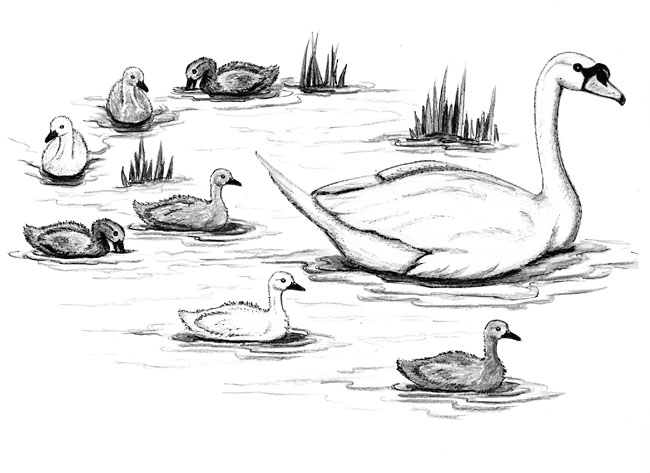
Dear Bird Folks,
We’ve been watching a family of swans in a local pond. In addition to the two parents, there are seven young ones. However, two of the young swans are white, while the other five are brown. Why aren’t all of the babies the same color?
– Marg and Frank, Brewster, MA
It’s Cape Cod, Marg and Frank,
If swans want to have some white babies and some brown babies, no one around here is going to stop them. Cape Cod is one of the most tolerant places on earth. Every lifestyle is welcome here. Haven’t you ever been to Provincetown? Talk about bending the rules. I know a guy from there who has both a dog and a cat. Can you imagine? In addition to that, we have customers who buy peanuts each week just to feed squirrels. Squirrels! Where else in the world would you find people feeding squirrels…on purpose? And to some extent, even Yankee fans are tolerated around here. Cape Cod is truly a bohemian’s utopia. The only two groups who can’t seem to get along are the wind power factions, but that’s not the Cape’s fault. Jimmy Carter couldn’t bring those two head-butters together.
North America only has two native species of swans and neither is likely to be seen on Cape Cod. The swan we see swimming in our ponds and bays is the introduced Mute Swan. Mute Swans are far from perfect. Depending upon who you talked to, they are either creatures of stately beauty or of great annoyance (much like myself). The peculiar thing about these swans is that the public loves them, while the authorities would like to see them disappear. This is a little ironic because often it’s the officials who push for protection of certain animals, while the public would rather have them eliminated. This is especially true for creatures like coyotes, Canada Geese, Piping Plovers and Yankee fans.
There is little doubt that Mute Swans are an invasive species, but since I’ve just finished saying that Cape Cod is place of tolerance, I’m not going to talk about their problems right now. I’ll just write a little about their natural history and we can talk about their ugly side some other time. That should save me from getting hate mail from the M.S.H.W. (Mute Swan Huggers of the World). That’s one nasty group…kind of like the swans.
Mute Swans typically form into pairs in late winter. Once paired up the two birds usually remain together for life. Divorce among swans is rare, but when it does occur it is most often the result of a failed nesting season. Bird couples that can’t reproduce have little reason to be together. The other possible reason for divorce is when the female complains that the male never talks to her. To which the male thinks to himself, “Hello? I’m a ‘Mute’ Swan. You knew that when you married me.” Either bird will quickly look for a new mate if the other one dies. Male Mute Swans are willing to accept either a younger or older female, but females generally only pick younger males for a new mate. They don’t want another old guy dropping dead on them.
When it comes to nest site selection, it’s the male’s job to find an acceptable location. He usually picks several spots and may even start nest construction on a few of them. But no matter how hard he works, it is the female that ultimately decides where the couple will live. (I know exactly how he feels.) On average the female lays six eggs and will do most of the incubating. Only when she gets up to find food will the male sit on the eggs. But since he lacks a brood batch, his egg sitting is mostly so he can tell his friends that he helps out around the nest. After about five weeks the young swans hatch out of their shells and are ready to take on the world. Here’s where things get interesting.
When the proud parents look at their brand new family of cygnets, the first thing they may notice is that the kids don’t all look the same. Some of their babies may be all white, while others may be totally gray. The shocked adult birds then turn to each other with a look of “What the heck?” – to which they both simultaneously reply, “Don’t look at me.” Producing swanlings of assorted colors may at first indicate fowl play (get it?), but it’s actually quite normal. For some reason, Marg and Frank, cygnets have two color morphs. For the first few months of their lives, young swans may be either white or gray/brown. But no matter which color they are at the beginning, eventually all the babies grow to look just like their parents, which means they all will be totally white, very handsome and really bad at dancing.
On a different topic: Here’s something that I mention every year at this time, although few heed my warning. While the rest of the country is focused on the infestation of bed bugs, there is one creature that continues to be ignored. I’m talking about meal moths. Meal moths live in all grain, including birdseed. They breed and hatch in warm weather. Folks who don’t cycle through their seed quickly run the risk of coming home to find a house or garage filled with little moths and webby, clumpy birdseed. My advice each summer is to buy smaller amounts of seed and use it up quickly. If you don’t, you may end up with buggy seed and I’ll end up getting yelled at. Believe me, I don’t need to hear any more yelling. I have enough trouble with the M.S.H.W.